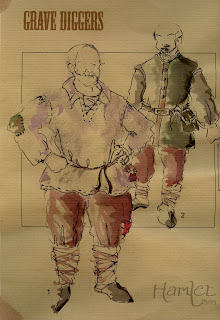The rendering technique for these final designs has truly combines digital and analogue process. The hand drawn-line drawings of a basic figure were scanned into the computer and manipulated in Photoshop. Printing these out I then used the figure to develop the costume design for each character. Once finalised these were then rescanned into the computer to cleaned up then arranged on a design template which was digitally created for the collection. Printing the final drawings on the brown paper gave them a textured and atmospheric quality. I then hand painted each design using drawing inks. I chose inks as I like the bleed quality of the media. Before painting each design I tested my chosen colour palette on the brown paper and adjusted the mix accordingly taking in to consideration the colour of the paper. Looking at this collection of design I can see pro and cons of using the process. When using the brown paper it warped slightly and in the future would probably need to be stretched before it was printed on. The warping was not a problem for the actual designs but when scanning them back into the images to retain a digital record of them, the scanner picked up all the creases in the paper. In addition hand rendering the colour on to the design limits the editing options therefore reducing some of the benefits which the digital platform can offer. The artistic result however, is much more interesting. The printed black line of the brown paper has a analogue ink looking quality which suits the hand rendering technique, while the layout offers a professional finish to the design as well as presenting it in an easliy accessible visual format. Some digital features were also added such as the lions on Claudius and the Guards as well as some pattern detail on Gertrude. This clarity sits well with the blurred lines of the inks and has bled slightly with the application of water to the design a similar way the analogue ink bleeds into the image

















